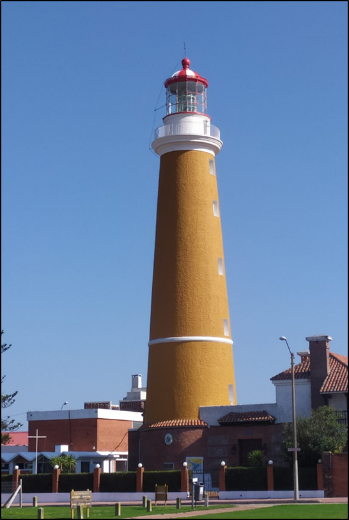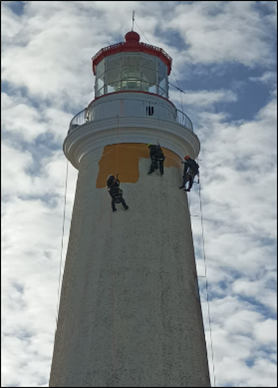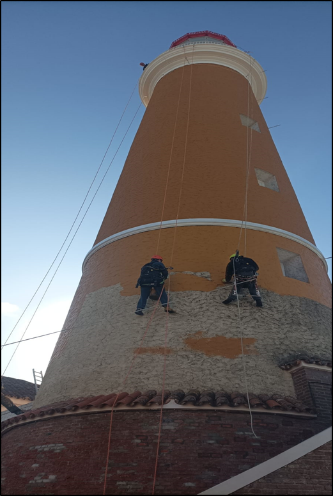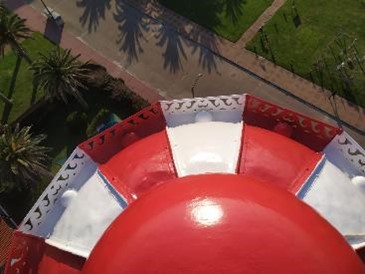Uruguay
Servicio de Illuminacion y Balizamiento Armada Nacional
Maintenance of the Punta del Este Lighthouse
The Punta del Este Lighthouse is located in Lat. 34° 58´08’’S Long. 054° 57′ 05”W, on the coast of the Atlantic Ocean in Punta del Este, Maldonado, Uruguay.
It was built on 1 March 1860. The material used in its structure was an amalgam of volcanic ash called roma earth, brought from Italy, which gives it long durability over time. Its cylindrical masonry tower has a focal height of 44 metres and its dome is composed of white and red radial stripes. Access to the top is via an internal staircase of 144 steps.
Its light range is 19.3 NM with white flashes every 8 seconds, it was built in order to guide navigation in the Atlantic Ocean and the Río de la Plata.
On 30 March 1976, the Lighthouse was declared a National Historic Monument. Currently, it continues to fulfil its original function, that of alerting navigators of landforms in the area. For several decades the Lighthouse was a walk made by all the people in Punta del Este. Tourists could go up and leave their signatures and comments in the book of memories, created in 1905 by the lighthouse keeper of that time, currently the lighthouse continues to be visited by hundreds of tourists each year.
On 10 May this year, its façade was restored involving a deep repair process in various areas.
Its characteristic ochre colour was restored. The task was carried out by personnel from the Navy’s Lighting and Beaconing Service with the support of Marine Corps Personnel, who have been trained and certified to carry out work at height.
The task was carried out in two stages, the first consisted of hydro-washing the entire structure, sealing cracks, and then painting began. The second stage was just painting with more emphasis on details. Glass replacement was also carried out as well as the replacement of the lightning conductor. Although it was not an easy task due to the agility and dexterity required, the objective was successfully achieved. The first week of August, the Dome was painted, giving it the final touch that would highlight the restoration of the entire façade of the Lighthouse.
Manteniento del Faro de Punta del Este
El Faro de Punta del Este se encuentra ubicado en la Latitud 34° 58´08’’S y Longitud 054° 57’ 05’’W, sobre la costa del Océano Atlántico en Punta del Este, Maldonado, Uruguay. El mismo fue construido el 1ero de marzo de 1860. El material utilizado en su estructuración fue una amalgama de ceniza volcánica llamada tierra roma, traída de Italia, que le otorga una larga durabilidad en el tiempo. Su torre cilíndrica de mampostería tiene una altura focal de 44 metros y su cúpula está compuesta por franjas radiales blancas y rojas. El acceso a la cima se realiza mediante una escalera interna de 144 escalones.
Su alcance lumínico es de 19.3 MN con destellos blancos cada 8 segundos, el mismo fue construido con el fin de orientar la navegación en el Océano Atlántico y el Río de la Plata.
El 30 de marzo de 1976 el Faro fue declarado Monumento Histórico Nacional. Actualmente, continúa cumpliendo su función original, la de alertar a los navegantes de accidentes geográficos en la zona. Por varias décadas el Faro fue un paseo realizado por todas las personas en Punta del Este. Los turistas podían ascender y dejar sus firmas y comentarios en el libro de los recuerdos, creado en 1905 por el farero de ese momento, actualmente el faro continúa siendo visitado por cientos de turistas al año.
El 10 de mayo del presente año se procedió a restaurar su fachada, realizando un profundo proceso de reparaciones en varias áreas.
Se restauró su color característico Ocre, la tarea fue realizada por personal del Servicio de Iluminación y Balizamiento de la Armada con apoyo de Personal del Comando de Infantería, los mismos cuentan con capacitación y certificación para realizar trabajos en altura.
La tarea se realizó en dos etapas, la primera consistió en un hidrolavado de toda la estructura, sellado de grietas y posteriormente se comenzó con el pintado. La segunda etapa fue solo de pintura haciendo más hincapié en los detalles. También se realizó recambio de cristales así como la sustitución del sistema de pararrayos. Si bien no fue una tarea sencilla por la agilidad y destreza que se requiere, el objetivo se cumplió con éxito. La primera semana de agosto se procedió al pintado de la Cúpula dándole el toque final que resaltaría la restauración de la fachada del Faro en su totalidad.




